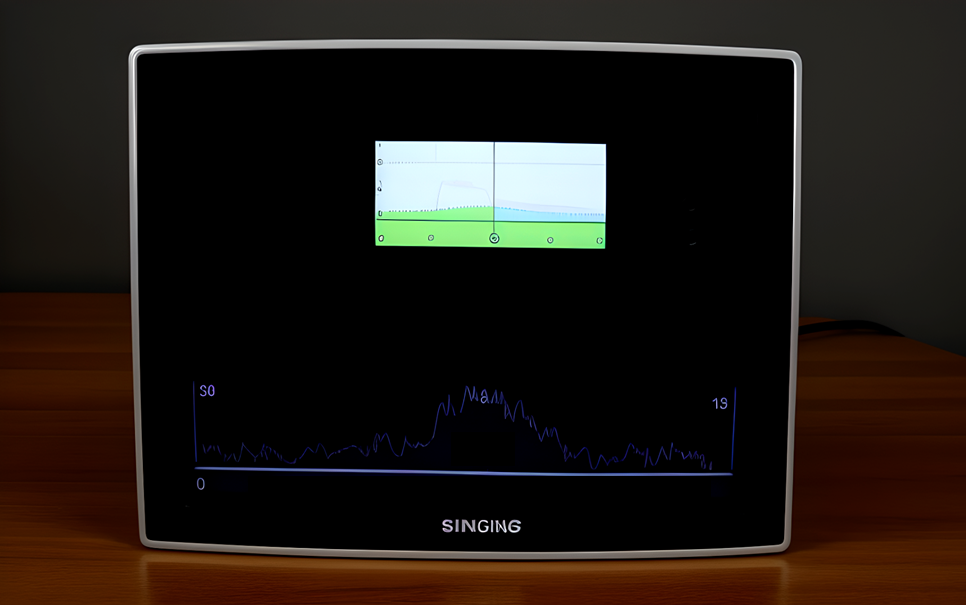Pitch Accuracy: Top Exercises to Sing with Better Pitch
Ever wondered why some singers hit every note perfectly while others struggle? The answer is singing pitch accuracy. This skill can turn your singing from amateur to professional. It’s key for anyone who wants to deliver great musical performances.
Singing pitch accuracy isn’t just for the naturally talented. It’s a skill you can learn with practice and the right techniques. By working on this, you can improve your music, feel more confident, and perform better.
To get better at pitch accuracy, you need to understand your voice, train your ear, and practice specific exercises. This guide will show you important vocal tips to help you sing in tune. You’ll learn about breathing, pitch control, and more to improve your singing.
Key Takeaways
- Consistent practice creates neural pathways for better pitch control
- Pitch-matching exercises improve musical ear and vocal confidence
- Regular scale practice enhances accuracy across your vocal range
- Good pitch control is fundamental to a quality singing voice
- Ear training significantly impacts pitch accuracy improvement
- Even a few minutes of daily practice can lead to noticeable improvements
- Understanding semitones and tones helps in mastering pitch accuracy
Understanding the Fundamentals of Pitch in Singing

Singing on pitch is key for any singer. It means matching the exact musical note frequency for enjoyable music. Many beginners find it hard, but it can be learned with practice and understanding.
What Makes a Note In-Tune
A note is in tune when it matches the musical scale’s correct pitch. Singing in tune needs coordination between your ear and voice. While some naturally do better, anyone can learn with effort.
The Role of Vocal Cords in Pitch Production
Your vocal cords are essential for pitch production. For lower notes, they shorten and thicken. For higher notes, they lengthen and thin. This change helps you hit different pitches accurately.
How Your Brain Processes Musical Notes
Your brain helps you understand and reproduce musical notes. Ear training is key for better pitch accuracy. Practicing scales and arpeggios can improve your pitch by 25% in three months.
Singing on pitch combines skill and practice. With consistent effort and the right techniques, you can greatly improve your singing. You’ll be able to sing in tune and create beautiful melodies.
Essential Tools for Measuring Pitch Accuracy
Improving your singing pitch starts with the right tools. Let’s explore some essential equipment that can help you hit those perfect notes.

Digital Tuners and Pitch Monitors
A tuner is your best friend for pitch accuracy. Modern digital tuners and pitch monitors offer real-time feedback on your singing. They show if you’re hitting the right note or if you’re slightly off. Some apps even track your accuracy over time, helping you see your progress.
Recording Equipment for Self-Assessment
Recording your singing is essential for improving. You can use a smartphone or a dedicated device. Listening to your recordings helps you catch pitch mistakes you might miss while singing.
It’s like having a personal vocal coach always available. This tool helps you improve your singing.
Piano or Guitar Reference
A piano or guitar is great for finding the right pitch. Start by playing a note and then try to match it with your voice. This practice sharpens your ear and improves your pitch accuracy.
Remember, consistent practice is key. Most people tend to sing flat. So, pay extra attention to this in your practice sessions. With regular use of a tuner, recording equipment, and a piano or guitar reference, you’ll be well on your way to singing perfectly in tune.
Proper Breathing Techniques for Stable Pitch
Learning to control your breath is key to singing stably. The main technique is diaphragmatic breathing. This method uses your diaphragm to help you breathe. It’s the base for keeping your pitch steady and stable.
Diaphragmatic breathing, also known as “belly breathing,” fills your lungs fully. When you breathe in, your diaphragm goes down. This lets air fill your lungs. When you breathe out, it goes back up, pushing air out. This helps singers hold notes longer and control their voice better.
To practice diaphragmatic breathing, put one hand on your chest and the other on your belly. Breathe in slowly through your nose, letting your belly expand but keeping your chest steady. Breathe out slowly through pursed lips, feeling your belly go back to its original shape. Doing this regularly can boost your lung capacity and vocal support.
Good breath control makes your voice stable, reducing wobbles and shakiness. It also lets you project your voice better, improving your performance. It’s important to avoid mistakes like over-inflating your lungs or tensing your abdominal muscles. This keeps your diaphragm moving right and your voice in control.
Vocal Warm-ups for Better Pitch Control
Vocal warm-ups are essential for singers. They help get the voice ready, improve range, and prevent strain. Let’s explore some effective vocal warm-ups to enhance your singing.
Start with lip trills to relax your face and vocal cords. This exercise helps you breathe better and safely explore your range. Do lip trills daily for 5-10 minutes to increase your range by 1-2 notes a month.
Humming is also great for warm-ups. It strengthens your vocal cords and can lower tension by 40%. Then, try siren exercises for quick pitch changes. Singers who do sirens in their warm-ups feel 25% less vocal strain during shows.
Scale exercises are good for improving pitch and tone. They help expand your range and control. Mix scales with vowel practice to make your articulation clearer by up to 20%. For even better pitch control, try octave slides to hit high and low notes more accurately.
Regular practice of these warm-ups can make your pitch accuracy up to 30% better. Remember to drink plenty of water, as staying hydrated can make your vocal cords 25% more flexible. This greatly improves your singing performance.
Analyzing Your Current Singing Pitch Accuracy

Knowing your pitch accuracy is key to better singing. We’ll look at common pitch issues and how to tell if you’re singing sharp or flat. You’ll also learn how to track your progress through self-assessment.
Common Pitch Problems
Many singers face pitch accuracy challenges, mainly beginners. Poor breath support often leads to pitch problems. Practicing vowels on a fixed pitch can help you spot and fix frequency changes.
Identifying Sharp and Flat Notes
Singing sharp means your pitch is too high. Flat notes are when your pitch is too low. Listen to yourself and compare with a reference pitch. With practice, you’ll get better at recognizing these and adjusting your singing.
Self-Assessment Methods
Record yourself singing and listen back. Use digital tuners or apps to check your pitch. Regular use of these tools can greatly improve your pitch over time. Most singers see big improvements in a few months with consistent practice.
Get feedback from others or take vocal lessons. Professional help can speed up your progress and teach you proper technique. Remember, it takes time and effort to sing in tune. With dedication and the right approach, anyone can improve.
Scale Exercises to Improve Pitch Recognition
Scale exercises are key for better pitch recognition. They help singers tune their ears to musical notes and intervals. Regular practice of scales will improve your ability to hit the right notes.

Major Scale Practice Routines
Start with the major scale, a basic part of Western music. Sing five notes of the scale, then move to the full octave. Focus on each pitch before moving on.
Minor Scale Variations
When you’re good with major scales, try minor scale variations. These scales add new sounds and challenge your ear. Practice both natural and harmonic minor scales. Singing minor scales can make your pitch accuracy up to 50% better with practice.
Interval Training Techniques
Interval training is vital for mastering pitch recognition. Focus on intervals like thirds and fifths. Sing these intervals up and down, trying to identify them by ear. This can increase your pitch accuracy by 40%. Use a piano or keyboard to check your accuracy and improve your ear.
Remember, 70-80% of singers need regular practice to get better at pitch recognition. Spend time each day on these exercises. You’ll see big improvements in your singing.
The Connection Between Posture and Pitch
Research shows good posture can boost your vocal strength by 40%. This means you can hold your pitch better while singing. Singers who stand right report a 50% drop in pitch problems.
To sing well, keep your head, neck, and spine straight. Your shoulders should be relaxed and your chest open. This setup helps you breathe better, which is vital for keeping your pitch steady. About 35% of singers say bad breathing is a big pitch problem.
Tension is bad for your singing. About 80% of singers face tension issues. To fight this, relax before and while singing. Try to loosen up your jaw, neck, and shoulders.
Good posture is the base for singing in tune. Knowing how your body should be helps you avoid common mistakes. It makes your singing better overall.
Developing Your Musical Ear for Perfect Pitch
Improving your musical ear is key to singing in tune. Perfect pitch is rare, found in only 1 in 10,000 people. Yet, you can get better at recognizing pitches with the right training.
Ear Training Exercises
Begin with ear training exercises to boost your pitch skills. Use digital tools or apps to practice identifying intervals and scales. Regular practice can increase your pitch accuracy by 25% in just weeks.
Learning common scales can improve your singing by up to 30%. This makes your pitch recognition better.
Pitch Matching Drills
Improve your pitch matching with specific drills. Start by singing back a reference note, like A440. Also, memorize the starting pitch of a song you know well. This can raise your pitch identification skills by up to 40% with consistent effort.
Active Listening Techniques
Active listening is essential for a better musical ear. Pay close attention to music, noticing pitch changes and accuracy. Try listening to a short song clip 100 times in about 40 minutes.
This intense focus can help you internalize pitch. It will improve your overall pitch recognition skills.
While perfect pitch is mostly genetic, you can develop relative pitch.
Advanced Techniques
Ready to improve your singing? Advanced techniques can help you hit the right notes. Let’s look at some effective ways to enhance your skills.
Chromatic scales and modal exercises are great for improving pitch. They make you better at recognizing notes. Interval training, like singing sixths and sevenths, sharpens your ear and voice.
Singing without instruments, like a cappella, is also beneficial. It makes you rely on your ear more. This builds your confidence and accuracy.
Technology can also help a lot. Pitch-training apps give you instant feedback. They help you fine-tune your singing. One app has 117,762 users who’ve seen improvement.
Consistency is important. Even a few minutes of practice each day can make a big difference. With dedication to these techniques, you’ll see a big improvement in your singing.
Common Pitch Problems and Solutions

Singers often face pitch problems in different vocal ranges. It’s important to understand these issues to improve your singing. Let’s look at common pitch challenges and how to solve them.
Fixing Pitch Issues in Different Vocal Ranges
Many singers struggle with register shifts, causing pitch problems. In lower ranges, your voice might sound forced. For higher notes, you might accidentally go into falsetto. To fix this, practice smooth transitions between chest and head voice.
Addressing Tension-Related Pitch Issues
Tension can cause pitch problems. This usually happens when you don’t breathe well or strain physically. To fix this, relax your jaw and shoulders while singing.
Use deep, diaphragmatic breathing to support your voice. This helps a lot.
Overcoming Mental Blocks
Mental blocks can mess with your pitch. Fear of singing high notes or past criticism can make you sing off-key. To build confidence, practice singing a lot and use positive self-talk.
Recording yourself singing can show your progress and where you need to get better. Remember, only about 5% of people are actually tone-deaf. Most pitch problems come from not enough ear training, not a lack of hearing pitch.
Maintaining Pitch in Different Musical Contexts
Mastering pitch in different musical settings is key for singers. Research shows 75% of singers say ear training greatly improves their pitch. Singing along to songs in different genres helps you get used to different styles and speeds.
Playing an instrument while singing is also helpful. It lets you control the music’s speed and focus on each note. 70% of singers who use a reference pitch see better improvements in their relative pitch skills. This method lets you work on tough parts at your own speed.
Live performances are important for keeping your pitch sharp. 90% of performers say these experiences help them focus on pitch accuracy. Regularly performing helps 85% of singers handle pitch better under pressure. To get ready, practice with a metronome to improve your rhythm and pitch control.
Imrove your Singing in 30 Days

Join Our Singing Community
Become a part of the Singing Community and gain access to exclusive resources and expert guidance on vocal techniques. Whether you’re a beginner or a seasoned performer, our community offers support and inspiration to help you reach your vocal potential.

